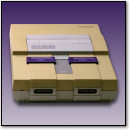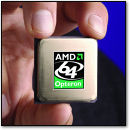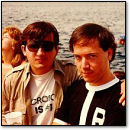VC&G Anthology Interview: Trip Hawkins on 30 Years of Electronic Arts (2012)
November 9th, 2015 by Benj Edwards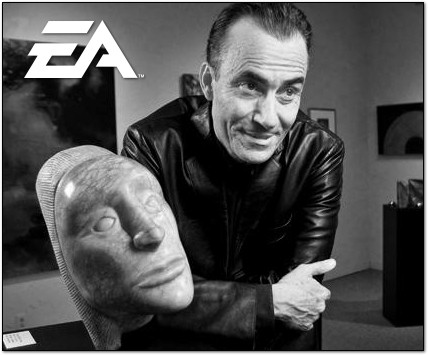
10 DAYS OF VINTAGE: Day 8
[ This interview I conducted was originally published on Edge.com in June 2012 to roughly coincide with Electronic Arts’ 30th Anniversary. Since then, the interview has disappeared from the web. A few people have asked me to make it available again, and since I retained the rights to the interview, I am free to publish it on VC&G for everyone to enjoy. ]
 Electronic Arts is 30 years old, and there is no denying that the behemoth game publisher casts a long shadow of influence over the entire industry. The company, founded in May 1982, pioneered a business model that treated game designers like rock stars and software publishers like record labels. It pushed the use of big names and big licenses in sports (think Madden, NFL) and soon grew to gobble up many renowned development studios to become a massive entertainment conglomerate.
Electronic Arts is 30 years old, and there is no denying that the behemoth game publisher casts a long shadow of influence over the entire industry. The company, founded in May 1982, pioneered a business model that treated game designers like rock stars and software publishers like record labels. It pushed the use of big names and big licenses in sports (think Madden, NFL) and soon grew to gobble up many renowned development studios to become a massive entertainment conglomerate.
These days, that conglomerate catches lots of flack from gamers on various issues including employee treatment, content milking, premature server termination, and more. Whether or not those criticisms have any merit, there is no denying that Electronic Arts was once revered as a top corporate impresario for identifying and cultivating the world’s best game design talent (although one would have to admit that time was very long ago).
The man behind the early, creatively-rich image of EA is Trip Hawkins, an Apple veteran who founded the company with a simple dream: to bring his sports simulations to life. Hawkins, now 58, left EA in 1991 to start The 3DO Company, which folded in 2003. He then launched mobile game developer Digital Chocolate that same year. Just recently, Hawkins announced he was stepping down as CEO of Digital Chocolate to face an as-yet unrevealed future.
In late May of this year [2012 — Ed.], on the occasion of EA’s 30th anniversary, I spoke with Hawkins over the telephone and via email about the creation of Electronic Arts, the design of its early games, and at some length about the negative criticism the company tends to attract today. Along the way, we touched on the personal source of his creative spirit and about heady days as a close friend of Apple co-founder Steve Jobs.

Inspiration for Electronic Arts
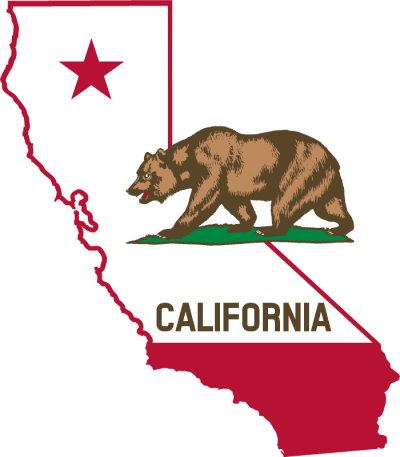 Benj Edwards: Are you from California natively?
Benj Edwards: Are you from California natively?
Trip Hawkins: Yeah. And so is my father. My grandparents’ generation came out of places like New York and Cleveland, but they started coming to California 100 years ago.
BE: What did your father do?
TH: He studied physics in college and then got into sales and marketing in the early electronics industry.
BE: Did your parents have any entrepreneurial spark to them that you may have inherited?
TH: I don’t think so. Actually, both my parents were very artistic. They were very, I’d say, innovative about exploring a variety of media for art. My father, on his own, started doing enormous wooden sculptures and oil paintings. He was an absolutely stunningly, unbelievable tropical gardener. He was really into that kind of creative expression.
My mother was a fantastic musician, played a bunch of different instruments. She sang. In fact, she’s actually in recordings from Carnegie Hall from choirs that she was in when she was in college. She also wrote poems. She could paint.
When we would do Halloween as a kid, we lived in a small town where all the kids would come out to the town square. They’d have a contest. Every year, my mom would make such amazing, creative, from-scratch outfits that our family would win all the prizes. You get a feeling, even when you’re very young, that, “OK, it’s cool to be creative. It’s cool to be original and different.” You’re being recognized.
In fact, I have a news clipping from my childhood where I’m in the newspaper at age six for winning an art contest. Just the idea of being artistic and being good at it and being recognized — that all started really early.
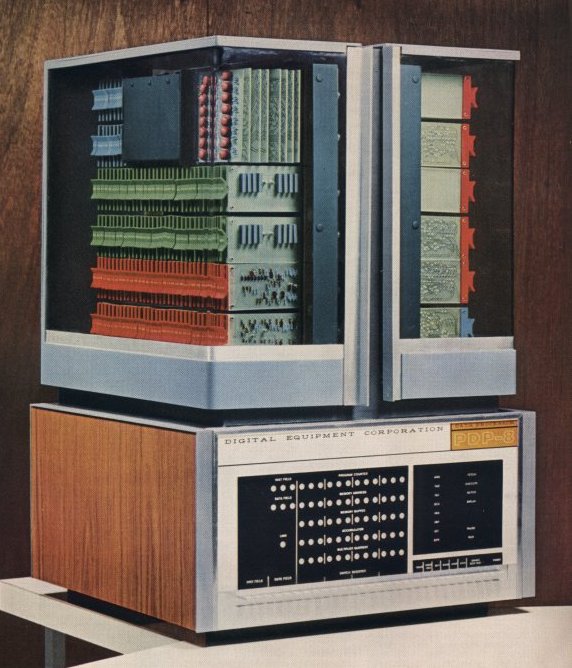 BE: What was the first computer you ever used?
BE: What was the first computer you ever used?
TH: My father had worked with a really brilliant engineer — a guy that later worked for Gremlin, one of the first arcade companies — who bought a DEC PDP-8 kit. This was 1971. It was sort of a block box with a bunch of switches and lights on the top of it.
He had it hooked up to a KSR-33 printer — the kind of printer that had a roll of yellow paper, and it would bang out 15 characters per second of text. He programmed a simple little matching game in assembly code. Basically, as soon as I saw that, I went, “Oh, I get it. You make the kind of games I want to make.”
BE: What kind of games did you want to make?
TH: When I was a kid, I played simulation board games. That included some of the Avalon Hill war games, and other hexagon-type war games from other companies. I did a certain amount of that, but what I really sunk my teeth into were the sports simulations that were done with cards, dice and charts. I played them all, but the one that I really got addicted to was Strat-O-Matic.
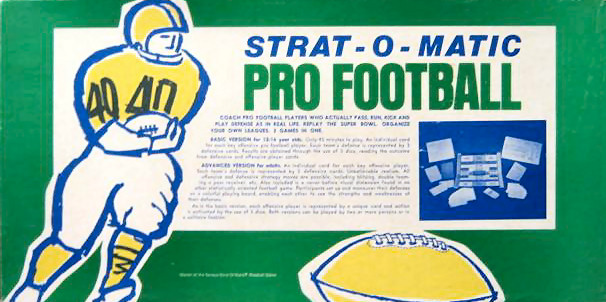 I started playing that when I was a kid in the 1960s, and I still play it, so I’ve been playing it for over half a century. When I was a kid, I was particularly a football fan, and I was most keen on getting friends to play Strat-O-Matic football with me. What I found was that a lot of my friends, when I was a kid, couldn’t really handle it. It was too much labor, the same way that, say, Dungeons & Dragons is high labor.
I started playing that when I was a kid in the 1960s, and I still play it, so I’ve been playing it for over half a century. When I was a kid, I was particularly a football fan, and I was most keen on getting friends to play Strat-O-Matic football with me. What I found was that a lot of my friends, when I was a kid, couldn’t really handle it. It was too much labor, the same way that, say, Dungeons & Dragons is high labor.
Basically, I found myself socially frustrated, because I wasn’t able to hang out and enjoy my friends in the way that I preferred. At the same time, I scratched this itch that I had for the intellectual stimulation of decision-making and running your own football team, and doing other kinds of simulation. Basically, the problem was that you had to be the computer.
BE: Lots of dice rolling.
TH: Yeah. You’re rolling dice, looking up things in tables and charts, calculating probabilities, and all of that. Of course, there were no graphics, no visuals, and that was the Golden Age of Television, so often, my friends preferred to watch TV. I could already tell that it was just kind of a boob tube. So I was set up to fall in love as soon as I saw a computer.
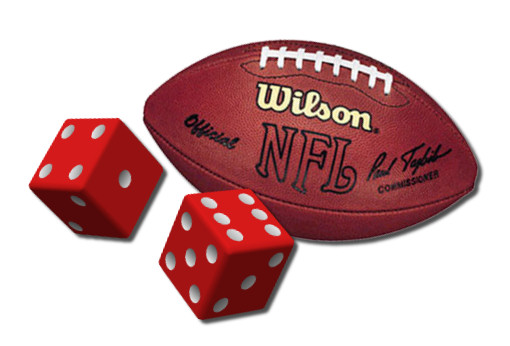 By then I had already designed my first game. It was a football game that was in the same genre as Strat-O-Matic. I had gotten it manufactured and published it, and sold a few hundred copies.
By then I had already designed my first game. It was a football game that was in the same genre as Strat-O-Matic. I had gotten it manufactured and published it, and sold a few hundred copies.
That was a real eye-opener for me, because I really, really enjoyed the entrepreneurship and the career side. Of course, I was disappointed that I’d failed. I borrowed $5,000 from my Dad, and I lost the money. I didn’t sell enough to keep me going, but I knew I was addicted at that point. That was in 1973.
By 1973, I was in school actually using computers. There was a PDP-11 and a PDP-10 in the computer labs that I used. After that, my real mission was to learn everything I needed to learn to start my own computer game company.
BE: What did you do next?
TH: I was working for a computer think tank in the summer of 1975, and a colleague told me about the invention of the microprocessor, and that he’d just been down the street in the first retail store where you could rent a computer terminal.
I went back to my desk, sat down, and said, “Well, if that’s what’s going on right now, I’m going to figure out how long it will be before there’s enough people with computer access in homes that I can sell games.” I sat there at my desk in 1975, and I decided that the answer was 1982.

Apple Computer and Steve Jobs
BE: You started working at Apple in 1978. Were you working on Electronic Arts in the background during that time?
 TH: The plan to start EA went on for 11 years before the actual incorporation. In 1971, I’m getting the “ah-ha” that I’m going to make computer games. In 1973, I’m getting practice as an entrepreneur with a game company that I’ve started. In 1975, I’ve decided that, OK, I’ll start my company in 1982. By then, I had my Game Theory academic program at Harvard. I had structured my college education around my plan to start Electronic Arts.
TH: The plan to start EA went on for 11 years before the actual incorporation. In 1971, I’m getting the “ah-ha” that I’m going to make computer games. In 1973, I’m getting practice as an entrepreneur with a game company that I’ve started. In 1975, I’ve decided that, OK, I’ll start my company in 1982. By then, I had my Game Theory academic program at Harvard. I had structured my college education around my plan to start Electronic Arts.
BE: Did you ever mention your plans for computer games to Apple executives?
TH: We might have talked about it on occasion. But Apple was not that interested in the consumer market, in general, or the game market. During my period at Apple, when I got there, [The Apple II] was a hobby product that, basically, you had to be a total hobby geek to get it. We had only sold about 1,000 of them, and they were almost in a kit form, frankly. There was some assembly required to do anything.
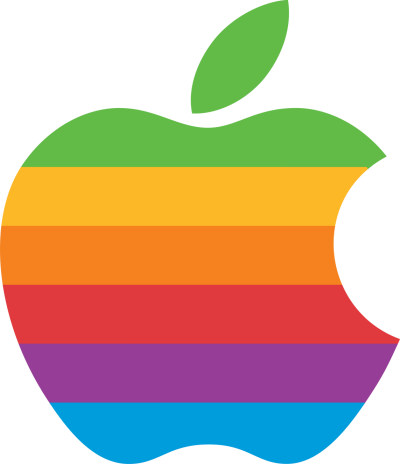 My boss, who was the guy that brought the first money into Apple, Mike Markkula, he said, “You have an MBA.” I had gone to business school and gotten an MBA, and I had been working on my own to study how to get where I wanted to go.
My boss, who was the guy that brought the first money into Apple, Mike Markkula, he said, “You have an MBA.” I had gone to business school and gotten an MBA, and I had been working on my own to study how to get where I wanted to go.
He said, “Look, you know something about business. You have an MBA. Go figure out how we can sell these to businesses.”
My focus at Apple was on getting into the business market and working on the product design principles that culminated in a Macintosh. For example, I was one of the guys that drove getting the mouse adopted by Apple.
Nobody at Apple really wanted to talk about games.
BE: Did employees of Apple play games on Apple II machines there? Was it part of the culture?
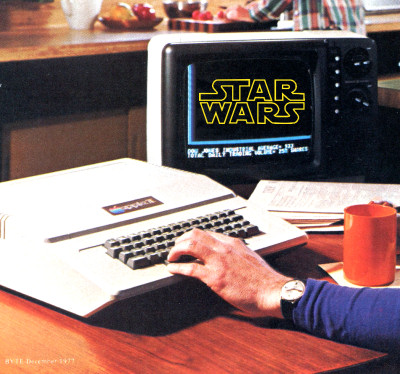 TH: No, not really. Honestly, the first time [Apple] went to the CES show, we didn’t have anything to show other than a really crippled little Asteroids-type game with the “Star Wars” name on it. It was hilarious because, in those days, people just rampantly trampled both copyright and trademark laws. And really, that was what we were doing to show off the machine. A guy from 20th Century Fox came up to me, gave me a business card, and said, “Yeah, you’re going to have to stop doing that.” [laughs]
TH: No, not really. Honestly, the first time [Apple] went to the CES show, we didn’t have anything to show other than a really crippled little Asteroids-type game with the “Star Wars” name on it. It was hilarious because, in those days, people just rampantly trampled both copyright and trademark laws. And really, that was what we were doing to show off the machine. A guy from 20th Century Fox came up to me, gave me a business card, and said, “Yeah, you’re going to have to stop doing that.” [laughs]
Other than that one stupid little game, it just wasn’t really important. It really wasn’t.
BE: How did Steve Jobs feel about computer games?
TH: Steve was always uninterested in games, his entire life.
BE: Even though he worked at Atari for a little while?
TH: I think while he was doing that, he was probably more fascinated with the design of the equipment and maybe issues associated with user interface.
Plus, obviously, in the very beginning, the machines couldn’t do very much. So you really had no choice. If you had to make a game, it had to be a really brain-dead, simple game, and that didn’t necessarily make you a game fanatic.
BE: Did Steve Jobs’ style influence you at EA later?
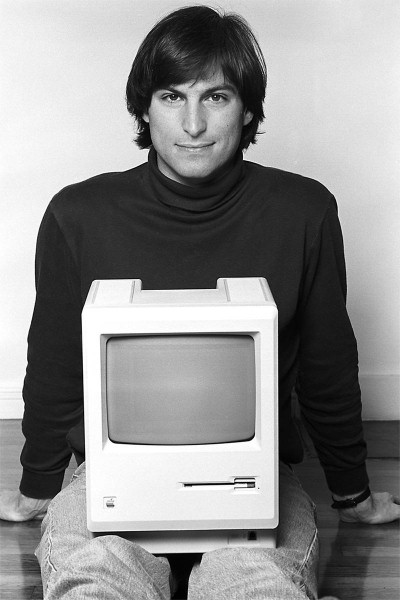 TH: Totally. Totally. I would say in both good ways and bad. He has a lot of bad habits. When you see people with bad habits get away with it and get what they want — unfortunately, I picked up some of that. On the other hand, I always, always, always was very different from Steve in terms of how I related to creative people. What Steve would do is he would pick out a few creative people and he would treat them very lovingly as peers, although he’d still occasionally rip into them. They knew that they were respected. It turns out he treated me that way.
TH: Totally. Totally. I would say in both good ways and bad. He has a lot of bad habits. When you see people with bad habits get away with it and get what they want — unfortunately, I picked up some of that. On the other hand, I always, always, always was very different from Steve in terms of how I related to creative people. What Steve would do is he would pick out a few creative people and he would treat them very lovingly as peers, although he’d still occasionally rip into them. They knew that they were respected. It turns out he treated me that way.
He respected me a great deal. He consulted with me about everything. I could influence him pretty easily. Occasionally, he would blow up and want to get in a fight about something, but you didn’t really worry about it because you knew how solid your position was.
With a lot of the rank and file people, he would literally take them apart. He could be really cruel. I have never been that way around creative people. I can be that way around business people because, as business people, I suppose, we’ve got to take it. There’s a lot of dishing it out and taking it that’s part of the sales and negotiation process of business.
Of course, for me, a really big moment with Steve was when he told me he thought I was really creative. That was maybe the first point in my life where somebody influential had told me that. That was empowering. Obviously, I was, and I am, and I was already expressing it. But it really boosted my confidence to hear that from him, because I knew how creative he was.
He inspired me a tremendous amount as a leader, and particularly as a public speaker, and his ability to persuade. I certainly paid really close attention to the details of how he did that.
BE: Did you feel like one of his peers?
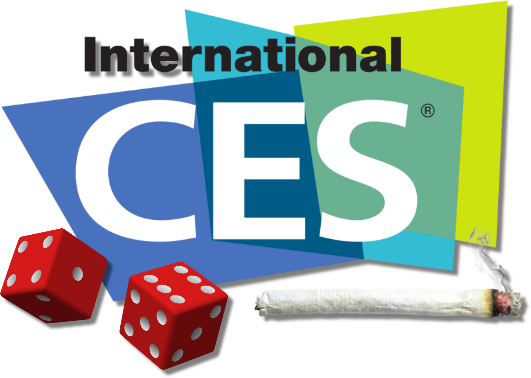 TH: Totally. We would talk about girlfriends. We would hang out. One time we were at a hotel at CES and smoked dope, and then went down and shot craps and made a bunch of money. It was hilarious. [chuckles]
TH: Totally. We would talk about girlfriends. We would hang out. One time we were at a hotel at CES and smoked dope, and then went down and shot craps and made a bunch of money. It was hilarious. [chuckles]
It’s unfortunate, because the way Steve operates is that as long as you’re loyal to his mission, he’s going to be friends. Then, unfortunately, he didn’t really understand how to be friends with somebody that was no longer in that context. Because he cared about me, he was really pissed off when I left. Then he permanently put me in the enemy category.
So even though I would see him socially from time to time, and he invited me to all the Pixar screens — probably because I was a celebrity. But you could tell that, at least emotionally and socially, he moved on and would rather think of me as being lower class, which is a shame.

Founding Electronic Arts
BE: When did you leave Apple to start EA?
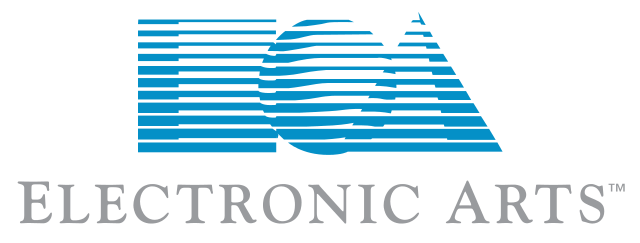 TH: On January 1, 1982, after four years at Apple, I resigned. I went off and I met with Don Valentine [a famed Silicon Valley venture capitalist — Ed.], and he offered me office space.
TH: On January 1, 1982, after four years at Apple, I resigned. I went off and I met with Don Valentine [a famed Silicon Valley venture capitalist — Ed.], and he offered me office space.
Then Apple basically convinced me to stay on. I’d been there for four years, and been very well treated, worked very closely with the founders, and felt loyal and obligated to stay if they were trying to lure me to stay. But after a few months, I just couldn’t do it, so I resigned again.
I’d been working on Electronic Arts for literally a decade up to that point. I’d already met with Valentine and had been offered office space. I then called him back and accepted the offer.
I worked out of my home office for a few months, and I incorporated the company in May [as “Amazin’ Software” — Ed.]. The name of the company was later changed, but it’s the same company.
BE: What were your favorite computer games before you started EA?
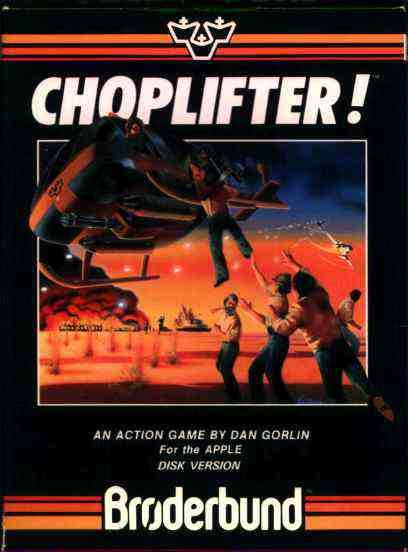 TH: On minicomputers in college, I loved the original Adventure game — AKA “Colossal Cave” — and my own games, including my football simulation of the 1973 Super Bowl.
TH: On minicomputers in college, I loved the original Adventure game — AKA “Colossal Cave” — and my own games, including my football simulation of the 1973 Super Bowl.
In the beginning of arcade games, I loved Pong like we all did, and I was also partial to Asteroids, Battlezone and Space Invaders.
Among the earliest home computer video games, I loved Choplifter and Cartels and Cutthroats. I liked games that had a good storyline and fantasy while also having real simulation elements that made it relevant and immersive.
BE: What made Electronic Arts different from other software publishers in the early days?
TH: I worked out a couple of the really foundational principles for EA while working at Apple. One of which was, I had the understanding that, in the very early days, game developers were basically making a game for the Apple II with the Apple II. I realized that, wow, that’s not really the way it works in any other profession. Professionals generally have more powerful tools than the equipment that the consumer has. And the Apple II is not really all that powerful.
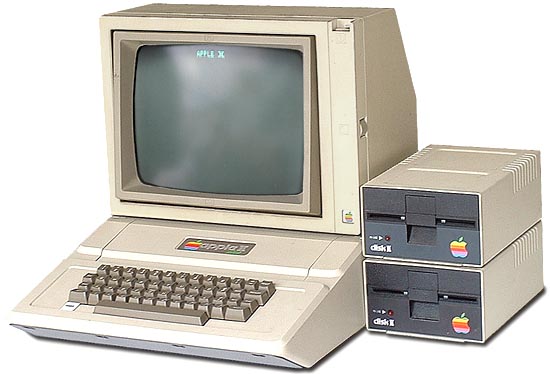 At that time, we were already working with 16-bit processors at Apple. They were not yet affordable for consumers. Around the same time, Sun got started, and they began selling 16-bit development workstations. There was definitely an awareness that there should be a technology angle to provide better tools.
At that time, we were already working with 16-bit processors at Apple. They were not yet affordable for consumers. Around the same time, Sun got started, and they began selling 16-bit development workstations. There was definitely an awareness that there should be a technology angle to provide better tools.
The other principle that I came into a very clear understanding about while at Apple was distribution. When I started at Apple, Apple had regional distributors and sold the computers to them. Then each of those distributors sold them to retailers in their region.
After a while it became very unmanageable. Apple did not really get a chance to influence and control what was happening at the retail point of sale where the brand connected with the public.
So we went through a very painful transition where we basically terminated the distributors and started going direct to our dealer base, which by then was a couple thousand retailers. It was very, very painful making that switch. The takeaway from that was that you should go direct from the very beginning to avoid the painful transition that Apple went through.
I had already started one company to make the board game, and I thought, “I don’t really want to start my company until I feel like I have a really big idea to anchor it around that really gives it a distinctive personality and strategy.”
BE: What was your big idea?
TH: By 1980, there started to be software applications [for the Apple II] because, at Apple, we had released a floppy disk drive in 1979. Once the floppy drive came out, it was possible for developers to program something in assembly code or BASIC, store it on floppy disks, and then press copies of the floppy disks and sell them.
SSI [Strategic Simulations, Inc. — Ed.], for example, was one of the first companies, in 1980, to release a game for the Apple II. Broderbund was another one.
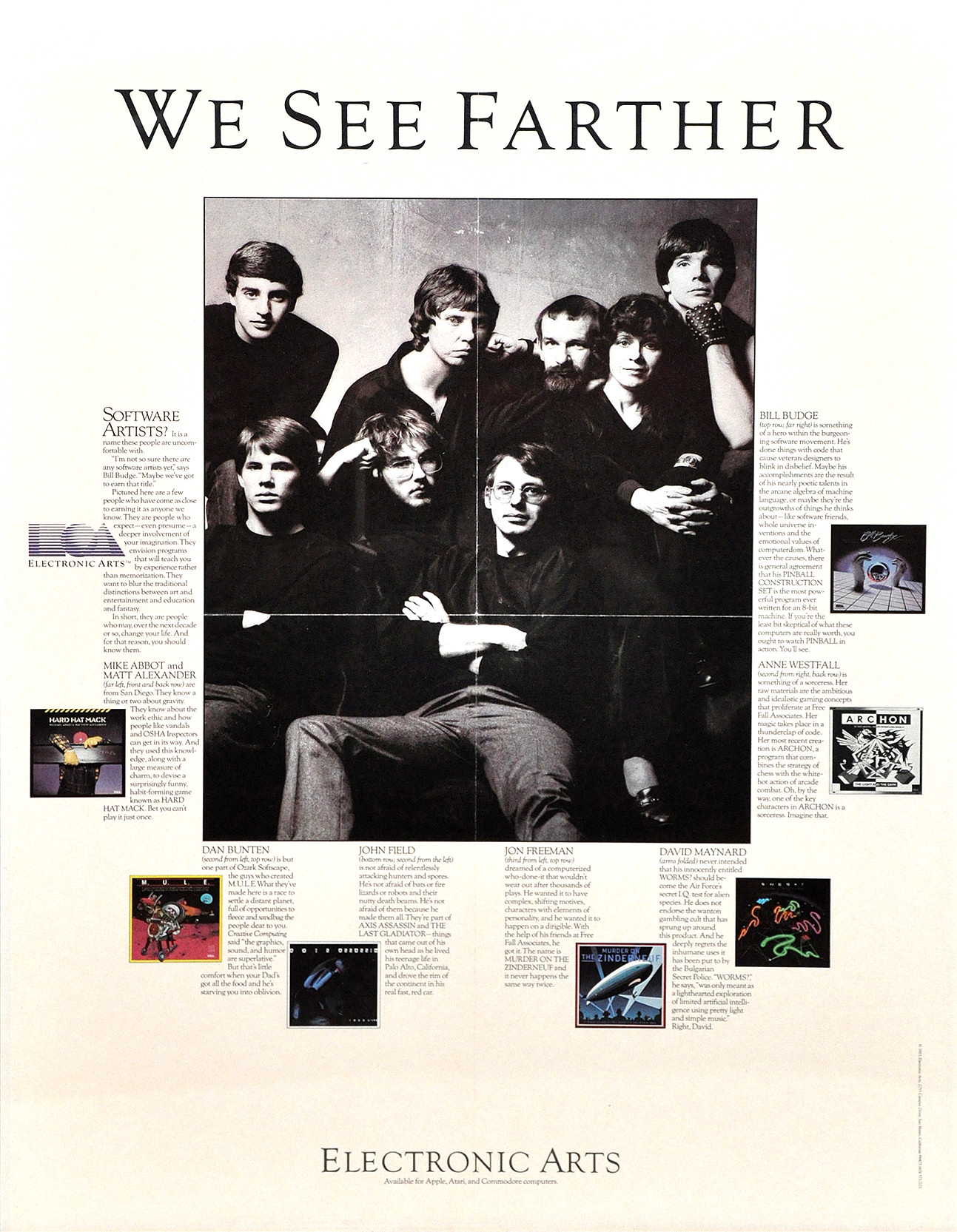 Of course, as this was going on, I was kind of wistful about it, because my timetable had been to wait until 1982, and here were these guys already doing it. I had joined the board of SSI to enjoy the ride and get some experience and help them, but I was still trying to say, “What’s my big idea?”
Of course, as this was going on, I was kind of wistful about it, because my timetable had been to wait until 1982, and here were these guys already doing it. I had joined the board of SSI to enjoy the ride and get some experience and help them, but I was still trying to say, “What’s my big idea?”
It came to me in the 1981 time frame, when I was working with the really incredibly talented software developers that we had at Apple. I realized that they were extremely creative divas that were pretty much, personality wise, like rock and roll stars, and that they needed to be treated like artists and managed that way.
Then I realized, “Well, hey. I can create the first technology company, the first engineering company, the first software company, that really operates like an entertainment company, and copies all the principles of Hollywood.”
My primary reference was the music industry because we had a lot of solo artists, basically — individual developers that did the whole thing. As soon as I got this core idea, I realized, “OK, what we can do is we can put the games inside something that feels like a record album. We can promote the name of the artist and have liner notes, and have a picture of the artist, and call them artists.”
I realized we were going to have a department that functions like what the record industry calls Artists and Repertoire, that has producers in it. I introduced the term “producer.” We were going to have directors that were going to help them from a technical standpoint.
Then we’re going to build tools that will basically give these guys the equivalent of a recording studio, to give them an advantage over a guy that just has a tape recorder and a guitar.
It was really clear that it was going to be a distinctive and revolutionary way to promote developers, support them, and basically present games to the public as an art form.
BE: Did Activision inspire you to treat designers like artists? They were crediting their designers too.
 TH: Activision had employees making their games. What they did is they put the name and a little head shot of their employee developer on the box. They used a conventional box.
TH: Activision had employees making their games. What they did is they put the name and a little head shot of their employee developer on the box. They used a conventional box.
What I did was use a record album format, and I had the artist’s name on the front. Not just on the back as a footnote, but the artist’s name was on the front. Then there was a whole lot of information about the artist in the packaging, as if it was a really cool rock and roll album. Activision was the first to give credit, but I was definitely the first to promote them like artists.
BE: It seems like you set out to raise the profile and respectability of the computer game as an entertainment medium. Was that one of your goals?
TH: Absolutely. I always wanted to make games a mainstream form of entertainment and art that everyone on earth would enjoy and take seriously. We’re getting there.

EA Artists
BE: How did you find developers like Bill Budge and Dan Bunten? Did you seek them out yourself?
TH: I developed a good network while at Apple, so I already knew Budge and Bunten and others. Budge worked with me at Apple, and I enjoyed Dan’s work that was published by SSI, where I was a board member.
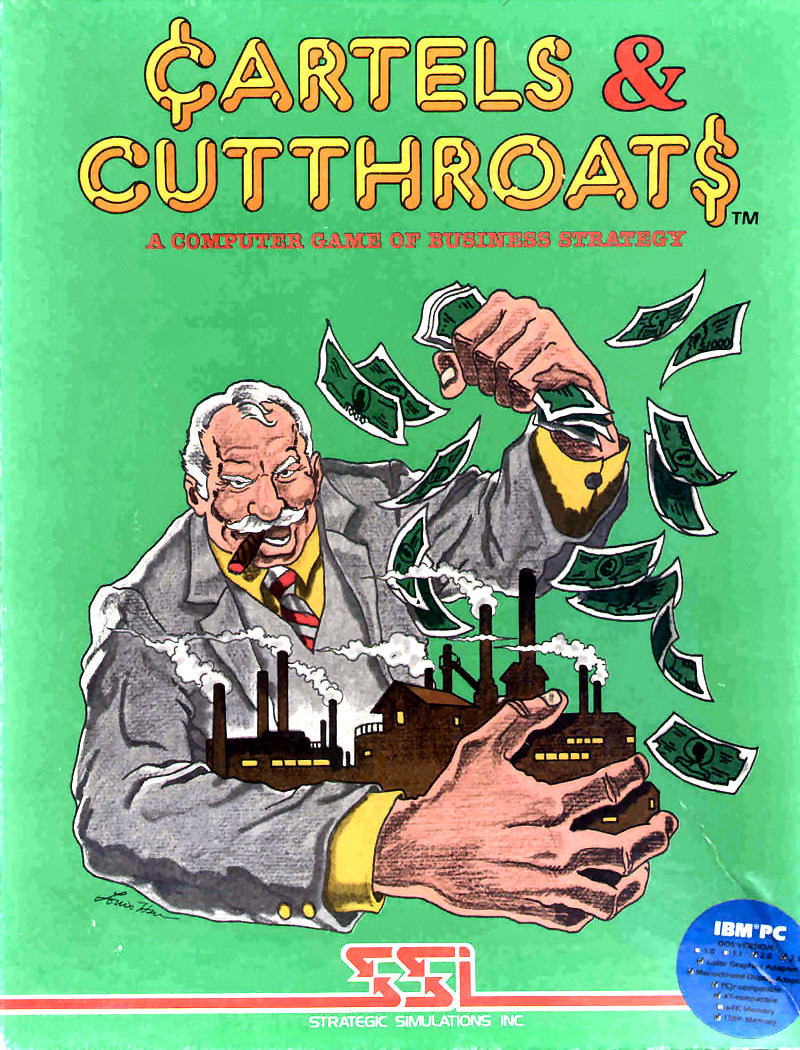 Dan produced a very simple, fun business simulator, Cartels and Cutthroats. When I started EA, I called up Joel Billings [SSI’s founder — Ed.] and I said, “Hey, I’d love to buy the rights to that game from you and make an improved version of it.” He didn’t want to do that, so I went to Dan directly and said, “Hey, let’s make a new game.” He said, “Great.” M.U.L.E. came out of my interest in basically making a more fun, playful, graphically-interesting business simulation.
Dan produced a very simple, fun business simulator, Cartels and Cutthroats. When I started EA, I called up Joel Billings [SSI’s founder — Ed.] and I said, “Hey, I’d love to buy the rights to that game from you and make an improved version of it.” He didn’t want to do that, so I went to Dan directly and said, “Hey, let’s make a new game.” He said, “Great.” M.U.L.E. came out of my interest in basically making a more fun, playful, graphically-interesting business simulation.
I would also scour the games, the stores, and the magazines and talk to a lot of people to build the network. I hunted Jon Freeman and Anne Westfall down at their home in the summer of 1982. It was so hot that day in Palo Alto that we were all wearing beach clothes and sweating profusely. Later on, I hired producers and made them scorch the earth. I heard about one great developer in Illinois, so I told the producer to call directory assistance for each and every area code in the state until we found him. And we did.
BE: Did you have any problems convincing any of them to sign up?
TH: Yes, I certainly did not get them all. Some stayed with what other arrangements they had. I also picked some bad ones that took advances and then could not deliver, and probably knew they couldn’t — even when they took the money.
I went particularly hard after my friend Bill Budge because he was my archetype for the software artist. To get him over the hump, I had to end up giving him some stock, which is something I did very rarely unless you were an employee. I also did that for Julius Erving later.
Every employee got stock. Every artist got royalties. I think I was the first guy to give advances against them, which made a big difference to developers.
BE: In the early days of EA, how did the game selection process work? Did the developers pitch you game ideas, or did EA originate the ideas?
TH: I would brainstorm ideas with my producers. They all reported directly to me, so in effect, I ran the product side personally in addition to being president and CEO.
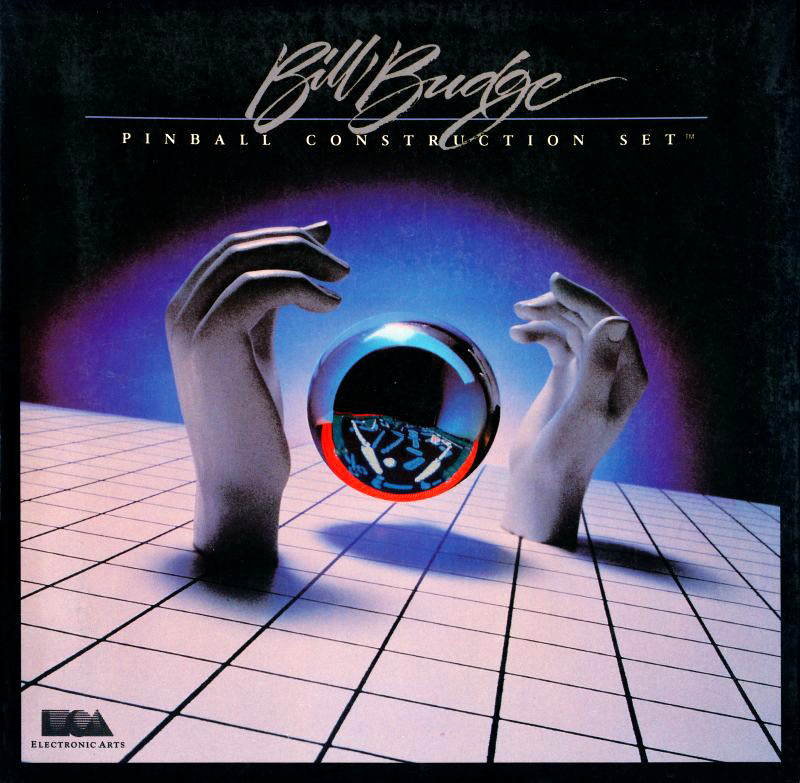 While having our own ideas, I really pushed for us to find artists that had great ideas of their own. An artist has passion for his own idea and will pursue it relentlessly to completion. If we saw an idea from an artist that we thought had great commercial potential, we wanted to do it. Great examples would include Budge’s Pinball Construction Set and the music app created by Will Harvey that we branded as Music Construction Set.
While having our own ideas, I really pushed for us to find artists that had great ideas of their own. An artist has passion for his own idea and will pursue it relentlessly to completion. If we saw an idea from an artist that we thought had great commercial potential, we wanted to do it. Great examples would include Budge’s Pinball Construction Set and the music app created by Will Harvey that we branded as Music Construction Set.
The main product lines that were more internally-driven were the sports games, driven very personally by me, and the creativity tools that were led by Tim Mott and some great developers that he hired to make our tools, including Dan Silva, author of Deluxe Paint.
We experimented across a wide variety of software initially. Mott and I partnered on a home productivity line where he built a really elegant and simple word processor I designed, and Tim’s team built a home finance app called The Financial Cookbook.
BE: Did you ever approach Richard Garriott to work with EA in the early days?
TH: Of course. I initially targeted Lord British, and we met in 1982. He was tied up with a really bad distributor and wanted to do it himself. He had the brand power and guts to do it. A few years later, I made a distribution deal with Origin, and we distributed some great games of theirs, including Ultima IV.

EA Game Production
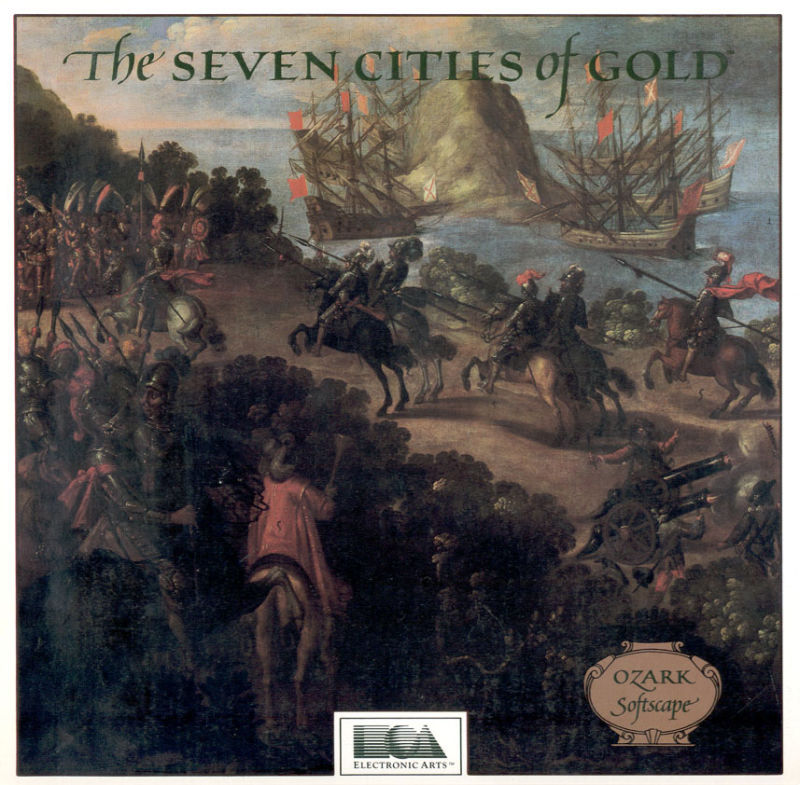 BE: M.U.L.E., Archon, and Seven Cities of Gold are three of the most critically acclaimed PC games of the 8-bit era. How did EA manage to snag all three?
BE: M.U.L.E., Archon, and Seven Cities of Gold are three of the most critically acclaimed PC games of the 8-bit era. How did EA manage to snag all three?
TH: Archon is totally my personal style of game, so when Jon and Anne proposed it to me, it was a no-brainer. It remains today one of the most elegant concepts and designs, not far beneath Tetris in the pantheon. Bunten and I resonated on what we cared about in games, and after M.U.L.E., his next game — produced by Joe Ybarra with little involvement from me — was Seven Cities. I think because of its historical aspect and commercial success, it must be considered his masterpiece. We all played that game into the ground.
BE: How closely did EA work with developers to design their games? How much design input did you have?
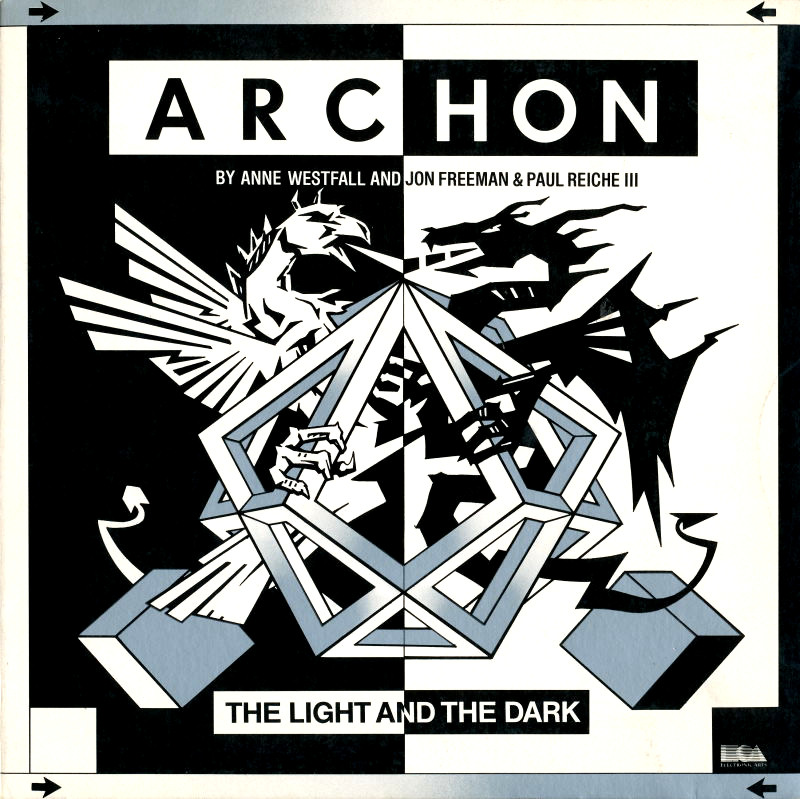 TH: We were all over the design details wherever it was necessary. Some projects, like Archon, needed absolutely no help, whereas I contributed key ideas to Archon II.
TH: We were all over the design details wherever it was necessary. Some projects, like Archon, needed absolutely no help, whereas I contributed key ideas to Archon II.
In other cases, like One on One and Madden Football, I really designed the whole game. I was often the executive producer, sometimes the producer, and almost always a contributing designer and tester or, in some cases, the primary designer and tester.
In those days, I got a lot of attention and publicity for being the founder and chief of the company, so I chose not to give myself credits in the games, but I did an awful lot of detailed design and production on an awful lot of games. I pioneered the whole dimension of celebrity and athlete designers and participants and personally handled most of the relationships.
Honestly, people began to ask me in the old days what I did, and I said my job was “to do whatever it is I cannot find someone else to do.”
BE: Did you personally have any role in the design of M.U.L.E.?
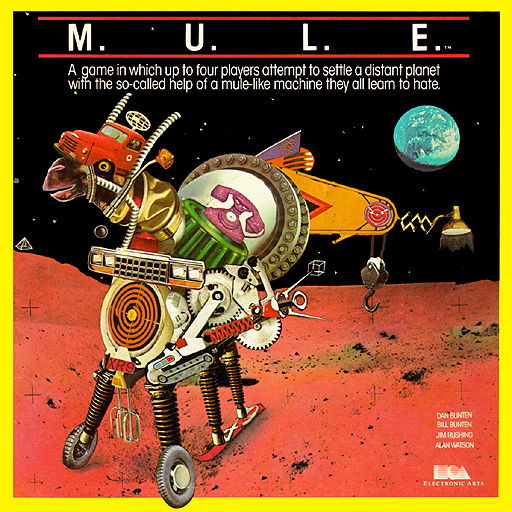 TH: It was my personal mission to bring to market a more visual and playful business simulation than Cartels and Cutthroats. I taught Dan Bunten the many economic principles that are built into the game design, including supply and demand, economies of scale, the learning curve theory of production, monopolies, auction principles, and other details.
TH: It was my personal mission to bring to market a more visual and playful business simulation than Cartels and Cutthroats. I taught Dan Bunten the many economic principles that are built into the game design, including supply and demand, economies of scale, the learning curve theory of production, monopolies, auction principles, and other details.
Because of my understanding, when it came time to write the manual for the game, I knew the game the best, so I wrote the manual. I also did that for some of the sports games.
BE: Looking back, what do you consider your greatest triumph at EA?
TH: When you look back at the launch of the company, it is shocking and remarkable that there were so many unique things that nobody else was doing that turned out to be the correct things to do. Obviously, that is why the company became great. People work hard in all companies, but if you are working on the things that turn out to be correct, you become a winner.
However, beyond the launch I believe the biggest real triumph was my decision to aggressively pivot to the Sega Genesis and to make a bigger commitment by reverse-engineering it. This was an episode similar to Lawrence of Arabia taking Aqaba after crossing the uncrossable Nefud desert. It took tremendous courage, leadership, determination and execution, and I will never forget what brave souls, like my hero Jim Nitchals, joined us on that perilous journey.

Electronic Arts Today
 BE: Did you hear about the Consumerist poll earlier this year that labeled EA the worst company in America?
BE: Did you hear about the Consumerist poll earlier this year that labeled EA the worst company in America?
TH: Yeah, I saw that. I think that’s a little harsh.
BE: There is an underlying current among gamers that EA is kind of an evil, corrupt company now. What do you think about that?
TH: I think it’s a shame. Obviously the company went through a transformation where we started out really focusing on art and artists. We tried a wide range of different kinds of products, including creativity tools and children’s educational products. We hit our stride with the sports games, which were really my baby and my passion. I was basically finally just bringing Strat-O-Matic into a computer to make it more social and more accessible and more audio/visually appealing.
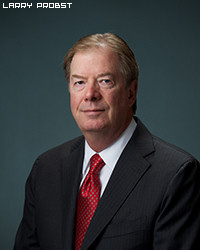 That became a real moneymaker — the more classic games and the sports games. The company obviously rallies financially around that. After a while, that was the entire focus. After a while, it shifts more to an operational focus, because you’re cranking out the same stuff every year. It’s all about operational efficiency.
That became a real moneymaker — the more classic games and the sports games. The company obviously rallies financially around that. After a while, that was the entire focus. After a while, it shifts more to an operational focus, because you’re cranking out the same stuff every year. It’s all about operational efficiency.
That’s more consistent with Larry Probst’s background [the CEO of EA after Hawkins — Ed.]. He did what he knew how to do well. He certainly did that sort of thing better than I would have. But basically, I think that I had a different idea about the culture of the company and the vision. Obviously that got lost over time.
Meanwhile, I don’t think they really noticed or cared because they’re making plenty of money. A lot of their games are really good. They certainly have always made a lot of good games.
BE: If you were in charge of EA today, how would you fix the company’s image problem?
TH: I think John Riccitiello right now is in a very good phase in which he’s got his heart in the right place and is trying to do the right thing. I think that includes a recognition of all the disruption that’s happening from new digital platforms and the shift to free-to-play with virtual goods, and the need to basically pivot the resources of the company and not over-invest in the old business models and not under-invest in the new ones. From what I’ve seen him say publicly, and what I’ve been hearing through the grapevine, he certainly seems like he’s pointed in the right direction.
BE: Would you do anything differently if you were the CEO?
TH: No, I don’t really want to speculate. I’m not the CEO and I’m not going to be the CEO. That’s a very difficult job. I have a lot of respect for anybody that wants that job and can actually get in that stuff.
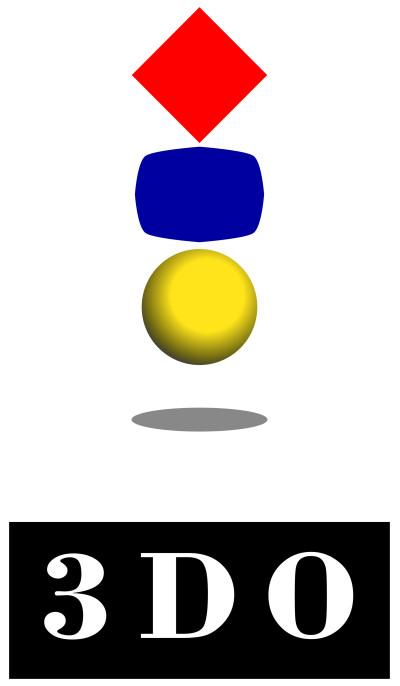 BE: Do ever regret that EA has a negative public image these days since it’s a company you founded? Do you worry that it reflects poorly on you in any way?
BE: Do ever regret that EA has a negative public image these days since it’s a company you founded? Do you worry that it reflects poorly on you in any way?
TH: No, I don’t think the modern image of EA reflects on me. I think I get dinged, obviously, for the 3DO image. Although, these images are mixed. Obviously the EA image has some very strong positives. I even hear a lot of positives from people about 3DO. So, hey, what the heck? As I’ve gotten older, I have fewer ego concerns about my status or my reputation. It’s simply a matter of history, and it is what it is. People feel one way or the other about it, and there you go.
BE: On May 25th, you announced that you were stepping down as CEO of Digital Chocolate. Any hints about your plans for the future? Perhaps a new game studio?
TH: I have no doubt that interesting things lie ahead of me. The game industry is changing very rapidly and I believe I understand where it is going. I think the game industry still needs me, and I still need it.


